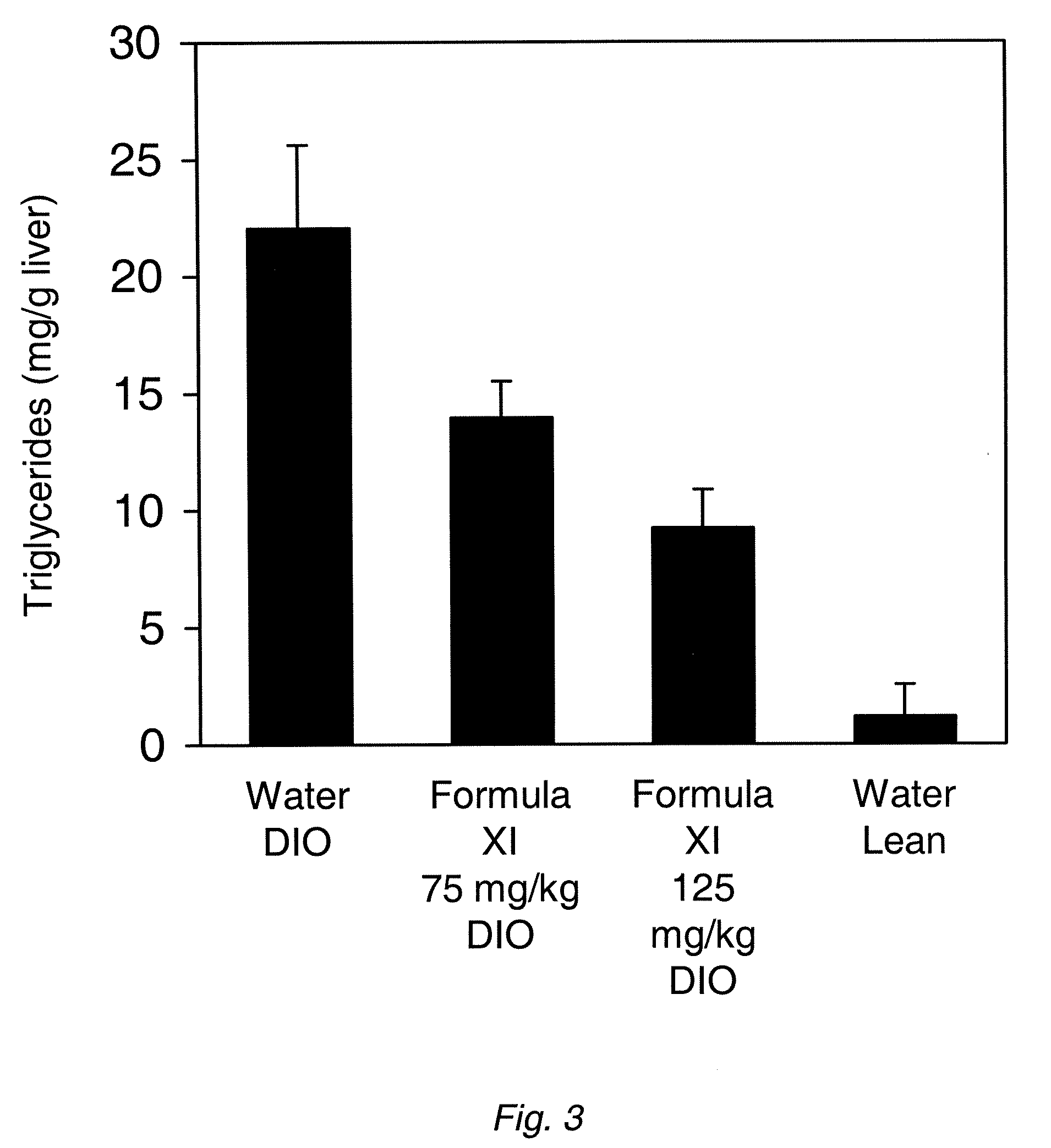Methods of treating fatty liver disease
a technology of hepatology and inhibition of glucosphingolipid synthesis, which is applied in the direction of biocide, drug composition, peptide/protein ingredients, etc., can solve the problems of chronic liver failure, hepatocellular carcinoma, and accumulation of lipids that may impair the circulation of hepatic microvascular cells, and achieve the effect of inhibiting glucosphingolipid synthesis
- Summary
- Abstract
- Description
- Claims
- Application Information
AI Technical Summary
Benefits of technology
Problems solved by technology
Method used
Image
Examples
example 1
Reduced Hepatic Steatosis in DIO Mice Treated with Formula XI
[0113]Diet-induced obese (DIO) mice were first generated by placing C57BU6 mice on a high-fat (45% of kcal) diet (D12451, Research Diets, Inc., New Brunswick, N.J.) for 8 weeks. Obese mice that had elevated glucose and insulin levels were selected and then treated with Formula XI by daily oral gavage (125 mg / kg) or with water as a control. After 10 weeks of treatment, the livers were harvested, sectioned, and stained with hematoxylin and eosin. Large vacuoles were visible throughout the parenchyma of the livers from the water control mice (FIGS. 2A-2C). These vacuoles contain neutral lipid by Oil Red O staining of the liver sections. In contrast, significantly fewer vacuoles were visible in the livers of mice treated with Formula XI, and those vacuoles were appreciably smaller compared to the controls (compare FIG. 2A and FIG. 2C with FIG. 2B). The results indicate that treatment with Formula XI is effective in treating he...
example 2
Treatment of DIO Mice Lowered Triglyceride Levels in the Liver
[0114]DIO mice were generated as described in Example 1 and then treated with Formula XI by daily oral gavage at a dose of 75 or 125 mg / kg. Mice gavaged with water served as the control. After 16 weeks of treatment the livers were harvested and homogenized. The lipids were extracted with methanol:chloroform (4.3:3 v / v) and CaCl2. The extracted lipids were dried and dissolved in dimethylsulfoxide (DMSO). Triglycerides were measured using the Serum Triglyceride Determination kit (Sigma-Aldrich, St. Louis, Mo.) according to the protocol supplied by the manufacturer. The results (FIG. 3) show a dose-dependent reduction in total triglyceride levels as a result of treatment with Formula XI, indicating that treatment with Formula XI is effective in treating hepatic steatosis in the livers of DIO mice.
example 3
Reduced Liver Weights in DIO Mice Treated with Formula XI
[0115]DIO mice were generated as described in Example 1. Mice were maintained on the high-fat diet for an additional 23 weeks (total time on diet 31 weeks). The mice were then treated with Formula XI by daily oral gavage (125 mg / kg / day). Drug treatment did not significantly affect body weight compared to the placebo (water) treated control group. After 9 and 17 weeks of treatment, groups of animals were sacrificed and the livers dissected and weighed. In the DIO mice, the liver weight to body weight ratio was higher than in lean animals. Treatment with Formula XI significantly reduced the liver weights, and after 17 weeks of treatment the liver / body weight ratio was comparable to that of the lean group (FIG. 4). This result suggests that drug treatment could reverse and normalize at least one measure of the gross pathology of the liver in the obese mice.
PUM
| Property | Measurement | Unit |
|---|---|---|
| mean corpuscular volume | aaaaa | aaaaa |
| mean corpuscular volume | aaaaa | aaaaa |
| mean corpuscular volume | aaaaa | aaaaa |
Abstract
Description
Claims
Application Information
 Login to View More
Login to View More - R&D
- Intellectual Property
- Life Sciences
- Materials
- Tech Scout
- Unparalleled Data Quality
- Higher Quality Content
- 60% Fewer Hallucinations
Browse by: Latest US Patents, China's latest patents, Technical Efficacy Thesaurus, Application Domain, Technology Topic, Popular Technical Reports.
© 2025 PatSnap. All rights reserved.Legal|Privacy policy|Modern Slavery Act Transparency Statement|Sitemap|About US| Contact US: help@patsnap.com



